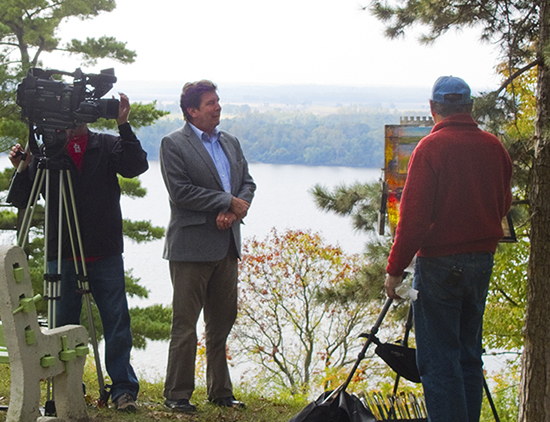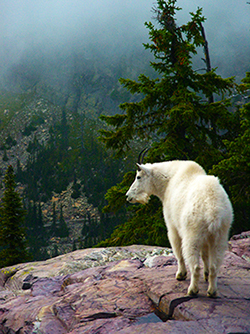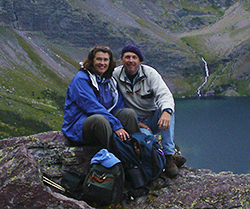Voices Of Experience - A Conversation with Robert GennVoices of Experience:
A Conversation with Robert Genn 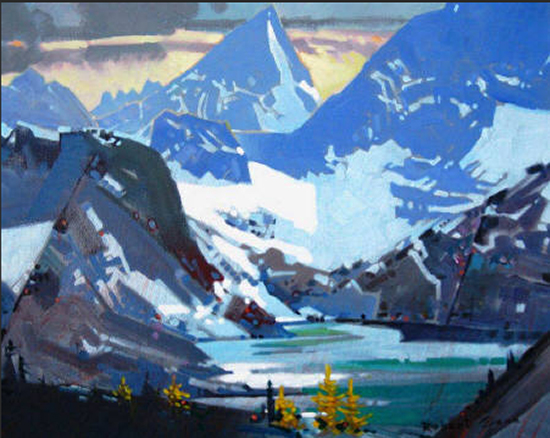 Cobalt Lake in the Bugaboos 16 x 20" Acrylic You have been writing your very popular “Twice-Weekly Letter” for artists for 12 years now, which is an amazing run. What made you decide to start doing that? Shortly after the publication of The Painter’s Keys, A Seminar with Robert Genn (1997), I was on a painting trip in Spain, and I got 20 emails about my book from folks who had read it. My daughter and her boyfriend were traveling with me, so I asked them if we could send the same letter out as a response to everyone who had written. We found an internet cafe, typed out a letter and sent it out. That was the beginning. I quickly realized that this was a great way of communicating with people and would allow me to teach on a personal basis. After all, a lot of artists are pretty private, rugged individualists. We now have about 50,000 direct subscribers, but another 250,000 people pick it up on other sites, etc. Isn’t the Letter a tremendous amount of work? It can be - the good ones take about 1/2 hour, the bad ones, maybe 5 hours! (like painting). In 12 years, I haven’t missed a letter. You seem genuinely interested in helping artists with this life, and we have always been impressed with your even-handed tone and diplomatic answers to sometimes antagonistic or anguished comments from readers. I try to always take the high ground. It is very easy to drop into vindictiveness when things in our professional lives go wrong, such as when one is suddenly dropped by a gallery, and so on. But that sort of attitude doesn’t help make things go right. I have often observed that the artists who thrive seem to figure it out as they go along. They are lifers at it, this university of hard knocks. Sometimes I can just fire off a two or three-sentence letter to somebody and it is quite helpful to them and it gives them fresh courage. At other times people are negative and they’re prepared to shoot themselves in the foot no matter what you say. Many years ago Ann and I began to make an effort to be more sympathetic to every artist that we met, no matter what their temperament, because we intimately understood the rigors and frustrations that can can dog one in this artist’s life. We felt that we needed to open our hearts to all our brother and sister artists out there. What is your feeling about that? I couldn’t agree with you more. This is the transformation that took place with me. When we’re younger we think it’s all about me, me, me, and I’m gonna get good and get rich and famous and all the rest of it. Then you get a chance to stand in front of a few people and your tendency is to be condescending and be above them. I cured myself of that very early on in my twenties by looking at a sea of women's faces in an art club and I paused. I looked at the faces one after another and I saw, mother, mother, mother - my mother, all struggling to find a place apart from their known course of being a mother and a homemaker and to indulge themselves into art. It was then that I realized, this is an absolutely wonderful way to connect with people - to empower them. If you treat people as equals right away, they come out and they thrive. They may not all get good or successful, but they become part of your life and it is one of the joys. My best friend in Vancouver is a retired businessman who happens to be my own age. He is one of the most giving, generous, successful people I know. One time he said, “Bob, it doesn’t matter what you do in life. It’s all about human relationships.” He’s absolutely right. Take time to get to know people. Most of those people are leading very interesting lives and they are well worth knowing. I just wish that I had more time to have them around my studio and to drink scotch with them and to get to know them more. 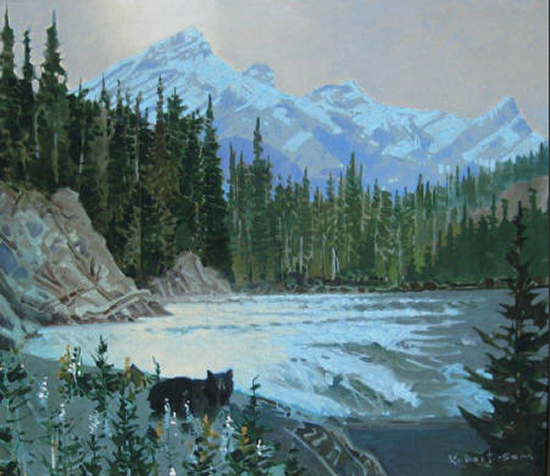 High Spirits 30 x 34" Acrylic You mentioned a motivational speech that you’ve been giving lately. Could you describe that a bit for us? Yes, its called “Twenty-Four Tips for Painterly Happiness and Success”, and has a lot to do with how to be your own best critic. That’s what I’m currently thinking right now is important, but it could change. It’s all fun. The trouble is, it’s like parenting. By the time you figure it out, it’s too late and the kids have left the house. The idea is that you don’t have to carry your work off to some mentor for an evaluation of whether or not it’s working. Many artists are very dependent on what others think of their work. We started the Artist’s Road to be encouraging and uplifting. We have a strong desire to share what we know about painting and our experiences over all these years - maybe give someone the idea that they can do this too. That’s my mission, also - sharing. I’ve never made a profit out of The Twice Weekly Letters. It’s always been subsidized by my painting. We have had some days when you sort of hit the jack pot in terms of viewers, but most of it is just incremental growth. We keep track of our subscribers and we’ve never had a week that we lost more subscribers than we gained. There are people unsubscribing all the time when they lose interest in painting or they read something that they don’t agree with, but there’s always more people getting on the carousel than getting off. You have invented a wonderful process, and you have something valuable to offer to them, I think. It’s not always easily obtained and it’s very satisfying when people write and say that they got some real value from what you’re talking about. There is a lot of injustice in art. That’s why you have to always feel that the joy of making the art is the main thing. If you get up every morning and come into your studio and have your crank turned, that’s a good day. Art is a blessing and a gift and a joy that we share. Painting has a way of defeating people - too much to learn and not enough time. It’s a great path to be on and to learn from other people and to stand on their shoulders and the rest of it, but it’s also nice to know that we’re all in this together. I’ve always found that if I go to another artist’s studio, even if I don’t like his or her work, I always learn something. It’s sufficient reason to be able to shift your ego for an hour once a week or once a month to do this because you find some dumb little thing that he’s doing - how he sharpens his pencils or some methodology. I’ll give you an example of the reverse. I’ve always used a maul stick. A lot of artists don’t use a maul stick and don’t believe in it. A lot of art schools say to never lean your hand on anything, rather, paint gesturally all the time. But I’m a believer in a maul stick. A long time ago I decided that what I needed was a maul stick that hangs. On my main studio easel I use an old ski pole. The circular part up at the top hooks around a nail at the top of my easel and is always hanging there ready to go. I can’t tell you how many people have ski poles for maul sticks now. It numbers in the hundreds, maybe the thousands, just as a useful thing. 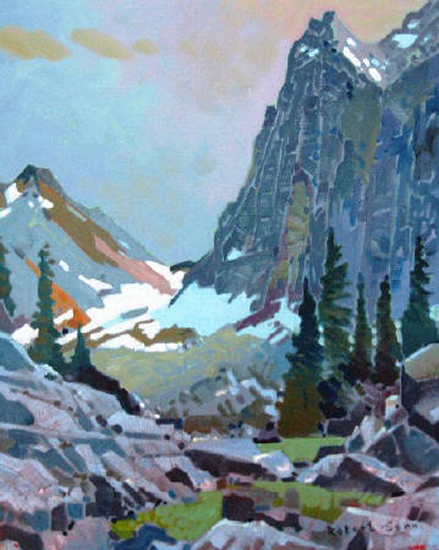 Light in the Opabin Yoho Park 20 x 16" Acrylic
Tell us something about your background and education in art. I was from square-one a painter and painted when I was in my teens - birds and wildlife. When I went to university I was still painting, some of it plein air but most of it in my home. A psychology professor recommended that I apply to Art Center School in Los Angeles, and I got in by the skin of my teeth. I studied industrial design because I was interested in designing cars. Fortunately, I continued painting the whole time I was studying other things. I didn’t finish the Industrial Design course, but returned to Canada and started showing my paintings right away here and soon got a fair amount of distribution around the country. I’ve also had the good fortune to have some very good mentors and friends who took an interest in me particularly when I was in my twenties and thirties. I’ve taken a few workshops but mostly I learned by sweating it out in the studio and reading books on the subject. Like Winston Churchill, I didn’t let my schooling stand in the way of my education. Today, I have about 15 galleries. I run the whole thing like a mutual fund - when one gallery is pulling the oars, another one is sleeping. Something always pops up like “Whack-A-Mole” and commissions come up. Some galleries I may not hear from for a year, and then all of a sudden I do. 10% of the galleries do 90% of the business for you. Some high-powered galleries don’t do a very good job and some little hole-in-the wall galleries who don’t have much prestige can do an excellent job because they make friends that stay with them. You said that you will be 76 this year. What motivates you today to keep painting? I’ve always been, for some reason, extremely curious about everything - studying animals and even mechanical things. I’m just curious. I kind of agree with Robert Louis Stevenson, “The world is so full of a number of things that I’m sure we should all be as happy as kings.” There’s some brilliance in that because as long as you’re curious, even if you’re bored waiting at a train station or a ferry terminal, there are always things you can study and look at. One of my earliest memories of traveling on a street car with my mum when I was about four years old was my mother saying to me, “Bobby, don’t stare at people.” I like staring at human personalities and I’m curious about the psychology of people and what makes them tick, but, I’m also just in love with the way things are with people. I’m also totally like that about species, trees, mountains, rocks, skies. I can amuse myself at practically any level. I’m afraid the conclusion is that the world of the imagination is probably better than the real world, which has its faults and problems. I think for a lot of artists it becomes natural to try to express themselves in a little object of a certain dimension, 11 x 14”, or 12 x 16” which has a kind of self-anointed perfection to it. Painting is great in that sense because each painting is a great event that you take from beginning to end and you sometimes succeed. It’s that hope and optimism that is a beautiful thing and that keeps you going. Do you have a well-established way of going about your work as some artists do, or do you just play it by ear, so to speak? I’m still trying a few different things, but I think when I was about 30 I became a little bit more formulaic in my approach to my work. What I mean by that is that I was able to get the best out of myself by a certain way of acting in life. One of the ways is penciling in projects lined up for the next year and the year after. I pencil in a place I want to go to and for some reason the gods align themselves and I end up going there. When I was a kid I found that I was up and down in my optimism/depression scale. I would go into a bit of the dumps for about 2, 3 or 4 days, or a week and I found that they were counter-productive to my working habits. I found that if I really pushed myself and got really depressed really fast, I could get through and out the other side in twenty minutes or half an hour. It might be just going for a walk or breathing deeply or going out in the countryside or just getting in the car, driving away for a few minutes and coming back. I was able to speed up my ups and downs and that was a great help to me. Another thing is that I’ve always been a bit of an early morning person. I’ve found that I can get quite a bit done between six and nine in the morning when everybody else is commuting or doing something else and that gives me a little bit of a feeling of positive purchase on the day. Cranking up in the morning is one of the things I believe in - squeezing out before your mind is in gear - that is, squeezing out your paint. You spend a lot of time thinking about what your process will be but the process for me comes from actually doing it. As long as I’m somewhat productive, even making crummy abortive sorties in my paintings, something comes out of it - good, bad or indifferent, sellable or not, it’s always fairly satisfactory. 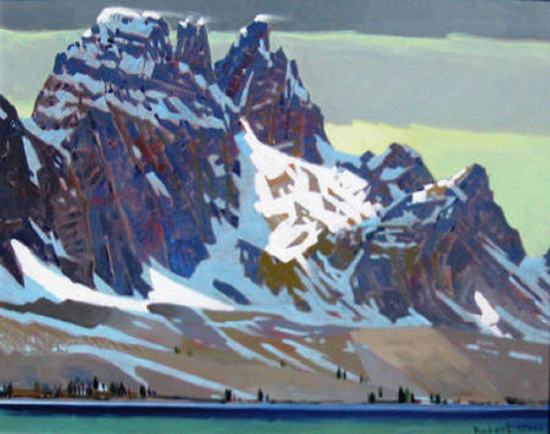 Above Amethyst Lake, Tonquin Valley 24 x 30" Acrylic Some artists pay attention to what paintings of theirs sell well, and that can be a motivating factor in what they decide to produce next. Everyone has to eat and pay bills, don't they? I don’t equate my income with the individual works that I do. After I pile up a supply of paintings I make an executive decision on which galleries are going to get which paintings, when and why and where and I send them off. My assistant wraps them and ships them and 2 or 3 or 4 months or a year later, checks come in, but I make a point of not correlating those checks with what sold and what didn’t. Money just gets taken to the bank but has nothing to do with the specifics. I’m honoring my own integrity more than anything and this may be a little bit contrapuntal to the idea of finding a niche and sticking with it. The most important and valuable thing is to wake up in the morning and come into your studio and ask a very vital question and that is, “What do I want to do today.” Sometimes it takes a half an hour or so to find out what that is and very often it’s prompted by what’s left unfinished on the easel. But if there’s nothing on the easel, then you tune into your needs, your internal metabolism, your needs of what you can get done. Some days you’re ambitious and optimistic and can work on a big project. Other days you’re not, and you need top pick something that’s fairly easy and maybe you can do two or three small ones in a day. You do it by looking at your reading and your studying for the period and by your sketches and photographic reference, etc. Sometimes it’s just that I’d like to get out in the woods and paint in the park or something and it’s all very, very selfish, but it’s an effective means for keeping your personal creative factory active. I’m not saying that it’s good for everybody. All of us become specialists in how we motivate ourselves, I think. I’ve not met one successful artist - I like to call them highly realized artists, who doesn’t have their own specific methodology and they are all a little bit different from each other. Although you and I might agree on a hell of a lot of things, you would have nuances to yours that would be highly effective for you to work at and Ann would have her own. Do you think that talent is more important than persistence and hard work to the success of an artist? One of the things I’ve studied all my life and have been really curious about is talent. I didn’t used to believe in talent, but now I do believe in talent. Some people are genuinely talented above others, but talent doesn’t always give you success. Some of the most talented people I’ve run into have other jobs and are miserable. Some people with not much talent can also develop the skills for self-management and find happiness. I’ve always had more ideas than the energy to put those ideas into art, but I’ve still been very prolific. I think that in order to be an apple vendor you have to have apples in your apple cart, obviously, and just be rather in love with making stuff. We all have disabilities: procrastination, inadequacy, stupidity - all those things that haunt us in various degrees. As you overcome them you get a certain amount of joy and satisfaction in beating them and out of it comes some sort of product, good, bad, or indifferent. 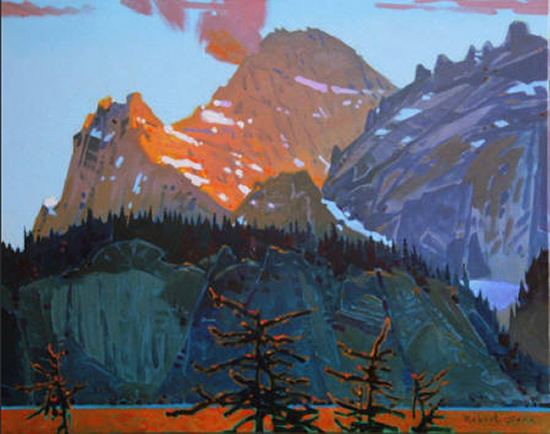 Into the Alpenglow, Opabin Plateau, Yoho Park, BC 24 x 30" Acrylic Are there any big creative questions that you are working on? I’m trying to get what I consider satisfactory designs and compositions and color. I find that color is still my biggest problem. Composition and design come a little easier to me as well as drawing. But it’s a hobby horse. I look at it as a puzzle - a joyous puzzle. If you think about painting as a game of solitaire that you play against yourself, or a game of chess or something, you might make early bad moves in order to work your way out of it and because do that it gives you a great deal of satisfaction. When you do really bad moves, compositional or whatever, it gives you an opportunity to use your creative brain to fix the problem. One of the valuable things I’ve been able to tell other artists is that it is important to constantly ask the question, “What could be?” When you ask “What could be”, you find yourself removing fence posts and putting a light on in the cabin, or putting smoke in the chimney or taking smoke out of the chimney, or adding the reflection of the boat in the water or any number of things that aren’t in the reference material but needed to be added to tell the story a little better. Charles Reid is one of the great artists who has written books on the subject. One of his best books is called, Painting What You Want to See (Practical Art Books) About twenty years ago, we rented a house in Brittany in Pont-Aven, where van Gogh and Gauguin lived for one summer. I found that area particularly brilliant. It was filled with fine ethnic costumes and dancing, so I painted some of the locals. We rented the Postmaster’s house in this small town. I painted 60 paintings and it was almost like I was on a bit of a high. One day I went to a beach not far from where we were living and I set up my easel and painted looking down at the beach with sort of a high horizon line and some waves crashing off in the distance. It was a great view - looking between rocks with the beach in the foreground and yellow sand. After I pretty-well completed the painting I realized that the composition was weak in the lower right-hand corner. When I got the painting home I painted my daughter standing at that place on the beach, which helped strengthen the composition. Long after the trip was over, I was looking at a photograph of my painting. It had gone out to a gallery and was already sold. I looked at the picture and thought, “You know I’ve seen this somewhere before.” I sorted through some books I had of Gauguin and I found a painting of his in which he had painted the exact scene from the same seat! He had put in a girl leading a cow, where I put in my daughter. I consciously didn’t remember Gauguin’s painting at the time I was painting there, but the fact of the matter is that we both figured out the same thing. That made me so happy! Since then one of my hobbies has been to go and find the places where various artists have sat in the past. That one was completely happenstance but, since then, I’ve sat on the exact place where Winston Churchill painted three or four paintings and I’ve found the exact place where John Singer Sargent painted Lake O’Hara. That painting is in the Fogg Museum in Boston. We have a famous female artist in Canada, dead now, Emily Carr, and I’ve painted in a lot of her locations. Of course, I’ve also painted in Monet’s garden. You can find all the spots where he painted, the bridge and the pond. 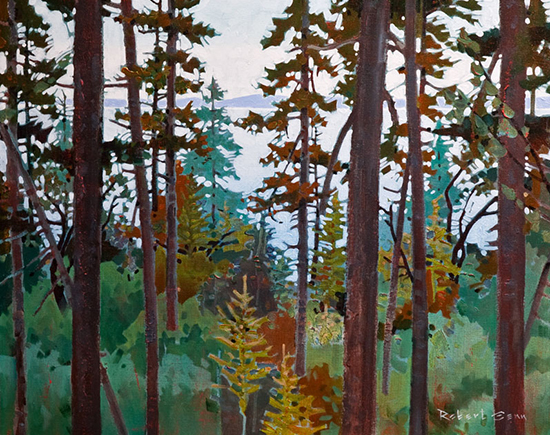 Into the Light at Kwomais Point 24 x 30" Acrylic It is obvious that you have a real love of travel, as we also do, especially to paint interesting places. Do you have any favorites you’d like to share, or perhaps places you are keen on seeing, but haven’t yet? I guess in my bucket list I have a bunch of places that I haven’t done and would like to. At the same time, we live on a beautiful piece of property with a beautiful view out over a bay and distant mountains. I keep saying to myself that if I were any kind of artist I would be better at painting this area, yet I’m starting to find the trees to be amorphous and the foregrounds not as interesting as they were a few years ago. So as you get older you spend more and more time traveling abroad in order to find things to inflict your style on. 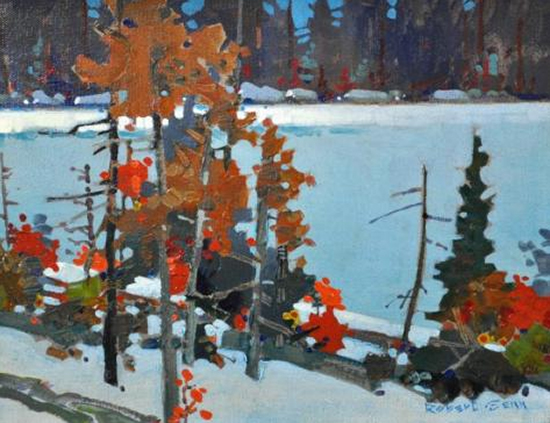 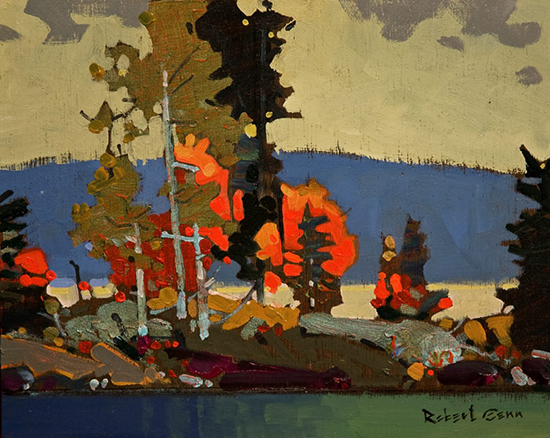 October Pattern with Red 11 x 14" October 17, Lake of the Woods 8 x 10"
We have a terrific area in Canada a couple of thousand miles away from here, north of Toronto - the Muskoka Lakes area - a beautiful area that’s been painted by some of our great Canadian artists. I was driving around there painting one or two paintings a day a few years ago. I pulled into a gas station to gas up and take a look around and noticed an outcropping of natural Laurentian Shield rocks coming out of the grass right beside the gas station. It was just the most fantastic, made-in-heaven foreground - better than what I’d seen anywhere else. After I got gas I pulled over to the side where I could still see this view and painted the rocks in the foreground of my canvas. There wasn’t anything else interesting near the gas station, so I left the rest of the canvas unfinished. It took me another week or so to eventually find something for the background, but the design of those rocks was what turned my crank. I can’t say that there’s any one specific place that I would call perfection. There is a thought that everything pales, everything perishes, everything passes and that we normally and naturally move on. Maybe we don’t get as big a thrill as we used to from certain things. You must remember the first time that you saw a certain kind of bird or the first time you saw a new Buick and then you get a little jaded about it after awhile. While I might say that I’ve always been curious, I’ve also been curious about why my curiosity has faded about some things and been revived by others. You have spoken about your “studio-dogs” before, and I think Emily was even on the cover of The Painter’s Keys. How important to you is the company of a loyal dog? I find that having a studio dog nearby when I work is very vital. Quite often when students from the art school and other places come out to see me, I ask them, “How much do you like to be alone?” They look at me and think, “What a funny question” because they’re used to working in the art school where everyone is in one big room with little kiosks and they think it’s sort of a social thing. In my experience most of the artists who are happy and well-adjusted and making a living at it work on their own and they keep their own company, but they have a dog or a cat. There’s always somebody there and it makes it kind of beautiful and joyful and it becomes part of your studio environment. Emily was an Airedale, and I liked her temperament so much that two months after she died, I got another Airedale, Dorothy, and we get along just fine. What do you think about the tremendous, sudden popularity of plein air painting? It looks like everyone has jumped on the same stylistic bandwagon. A lot of the artists that are painting in that particular stye - American Impressionism, or whatever you want to call it - are doing pretty good work. It is better work, on average, than what was going on a few years ago when other styles were more predominant, but as you say, probably things can get overdone. A while back I was invited to go down and jury a show in Indianapolis. I had never been to Indianapolis before and I wanted to go to the raceway to take a look at it, so I accepted this jurying and speech opportunity. Thirty artists had been chosen to exhibit two paintings each. The main body of the jurying had been done and all I had to do was pick out number one, number two, number three and three honorable mentions. I walked into this show and I could swear that it was painted by the same person - 30 different artists, 60 paintings. With a couple of exceptions, it was nearly all in the American Impressionism style. Recently I was jurying a show in Winnipeg, Manitoba where the habit hasn’t caught on yet. Every painting was different. They were all over the place, primitive, abstract, modern, realism, tight, loose. At least with the American Impressionists, there is a fair degree of consistency of quality and rather nice brushwork. I think Richard Schmid has done an amazing amount of getting the ball rolling. But now there are hundreds of - California is chock-a-block with them. A lot of it has got to do with the environment and the type of subject matter people choose. I can name a lot of artists who do really, really well in Arizona and New Mexico with their hot warm lights and beautiful purple shadows and all the rest of it. 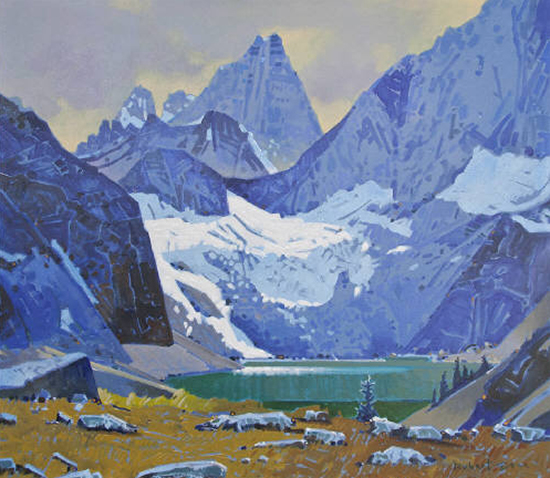 Above Cobalt Lake, The Bugaboos 30 x 34" Acrylic
I’ve been doing a workshop for the last two years and I’m doing it again this year in the Bugaboos - a mountain range in British Columbia. It’s called heli-painting. We stay at a lodge at about 4,000 feet and we fly up to 8,000 - 9,000 feet. The helicopter puts you down with all your gear and stuff. Last year I took 14 people up, but I don’t know how many I’m going to take this year. The environment is so gob-smackingly beautiful that even fairly amateur people do fantastic work. We were blown away this year. We had a little show at the end of it and we sold a bunch of paintings to the people who were in the lodge. People just were so surprised at the quality of the environment - it is a ready-made painting. At first, you feel guilty as hell when you get into the helicopter, but five minutes later when you land you realize that you saved yourself four hours of heavy hiking carrying a lot of crap! You get out of the helicopter and you see ten different views and they are all winners. No doubt the students get an incredible experience out of the deal. Workshops can be hard work for the instructor and they take a lot of energy. Do you try to take on any other workshop commitments during the year? They do get a life experience. We also do a workshop at Hollyhock (Canada’s Lifelong Learning Center in British Columbia). That’s a bigger one. This year we cut it down to 32 people and as far as I know none of the people that went to the island last year are going this year. They are all new people and it may be because the thing was so popular people were waiting to get in. It’s a bit of a job to do the workshops. I’m pretty good at it but I don’t want to do it too regularly because if I do it too regularly I won’t be too good at it. If I have a fair space between workshops, I’m full of energy for the second one, so I’ve got it down to two a year. They’re places that I want to paint and I can be enthusiastic about and see results. I prefer to work with people who are a little more advanced than people who are rank beginners. We find that we always meet such interesting, nice people at our workshops. Often they are not full-time artists, but highly accomplished, successful professional folks who also love to paint. What blows my mind is that one guy turns out to be a brain surgeon and another guy has had a very colorful life in business. You meet a range of them. That’s the biggest joy of this thing - the connectivity to the brotherhood and sisterhood that is virtually all over the world. There is a certain cultural cachet to being an artist, don’t you think? We have found in our travels that, being artists gives us access to people and places that otherwise might not be so open with us. Have you found this to be true, as well? One of the real blessings of being an artist is that pretty well everybody thinks you’re interesting whether you’re interesting or not. When Carol and I were first married we lived in Spain for a year and a half in a place called Fuengirola which is near Malaga. Not having any cash flow, I went down and negotiated to use a space as a gallery in the hotel that was within view of where we were living. We went through some time at the beginning when we didn’t sell a painting. Carol was down there every day sitting around the gallery trying to sell my paintings and every day somebody would come in and Carol would strike up a conversation. She would come home at lunchtime or for the siesta time and she would say, “You know, so-and-so from Germany came in today. Didn’t speak very good English but he seemed like an interesting guy and his wife was interesting, too.” I would say, “Well, let’s have them up for a drink after,” and so we made friends that we still know, still interact with, and that we still go and see in Germany, Denmark, England, France, the USA and Canada. One of my top collectors in Canada walked into our gallery in Spain. One couple walked into the gallery and started chatting with Carol. We invited them up for a cup of tea. We invited them to go to another village together with us. Then we had another cup of tea. Then we met for dinner. Then we played bridge, believe it or not. The subsequent outcome of it was that we ended up becoming god-parents to Bert and Eileen's children. Even though they are both dead now, we have a lifetime connection with this family because of the time that we had in that gallery. What drew you to Spain? When we first got married, we flew to Amsterdam and borrowed a car for a month or so from some friends that we knew there. Then we took the train down to Frankfurt and bought a used VW Camper for about $500. I fitted it out myself so we could sleep in it and we drove around Europe for about six months. We decided that we needed to settle down and found this place in southern Spain - Fuengirola. We were able to rent a very, very nice house, a beautiful big home, painted white in the Andalusian style. It had lots of rooms in it and it was ideal for painting. Fuengirola was just absolutely jumping with subject matter - everything from fishing boats to donkeys and wine-pressing people and orange gatherers. We loved the Andalusian white-washed atmosphere with the soft rounded corners to windows and things like that. It just lent itself to painting. One of the main reasons that I went there was that I knew that Joaquin Sorolla had painted on that beach. That turned my crank and so we hung out there for a year, opened a bank account and did okay. We’ve been back there a couple of times since, but it’s turned into Miami. It’s hopeless now, but in those days it was beautiful. It had a beautiful view of a castle that I painted from the house a dozen times. 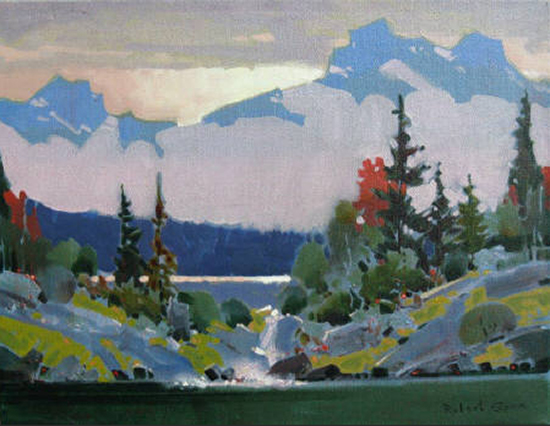 Counterpoint on the Jasper Parkway 14 x 18" Acrylic So much of the character of unique places all over the world has been destroyed by insensitive development. I think every generation has said that, but there are some beautiful corners of the world yet to be explored and Canada is one of them. We have this unbelievable environment, 99% of which has not been spoiled. I’m right on the west coast, but I’ve painted in every province of Canada except Newfoundland and Prince Edward Island. I consider the world to be my country, but this is a place where you go hiking and you don’t run into any other Canadians. You run into a few Aussies and a few Germans. Basically you’re looking at the sky and the rocks and the trees and the water and the bear paths. There are quite a few bears in our country. Do you ever take breaks from painting, teaching and lecturing? If I go through a period when I’m not working - having too good of a time, outside, I’m not happy. One of the things I started doing about 25 years ago is going fishing with my friends. We do quite a bit of fishing on the coast. I found that three or four days of dragging a line in the water is pretty boring, so about 15 years ago I decided to take my paint box with me. I figured I could fish and paint at the same time. When you’re fishing on a boat and painting, before long you start thinking, “By God I’d be doing better off over there on that point of land.” So I would get my friends to drop me off. Now, I fish half as much as my friends, but I still catch as many fish generally, not always, but generally. The fact of the matter is, I’ve got some really good stuff to put in my box when I’m done to take home. It sounds like you really enjoy combining fishing and painting. Taking a bunch of smoked fish back to the house is okay, but they cost about $1,000 a pound by the time you pay for staying in the fancy lodging and everything! It’s a false sense of satisfaction. Eventually, I found that those times when the girls from the lodge would drop me off at the beach so that I can paint for a few hours and then come back to pick me up so that I could fish in the afternoon segment I felt much better about myself for the day. When you think about it, what we do is very much like hunting and fishing. We go out in the field and we get the stuff and we bring it back in, but the interesting thing about it is that we don’t kill anything or damage the environment while we’re doing it. It’s just like shooting grouse, but we don’t shoot them, pluck them and eat them. Both fishing and painting have a zen-like quality to them. It is valuable for its own sake except that I think there’s more brains in the painting than in the fishing. One of my favorite writers is an Irish guy by the name of Oliver St. John Gogarty. He used to fish on a little lake called Heath Lake in western Ireland. One of the things he insisted on doing was fishing without a hook on the end so that he could just have the joy of getting away from the house, floating on the water, dragging a line and making it look like he was fishing. You can fish all day and not catch a fish and still call it fishing. You can’t go out to paint and not paint and call it painting. 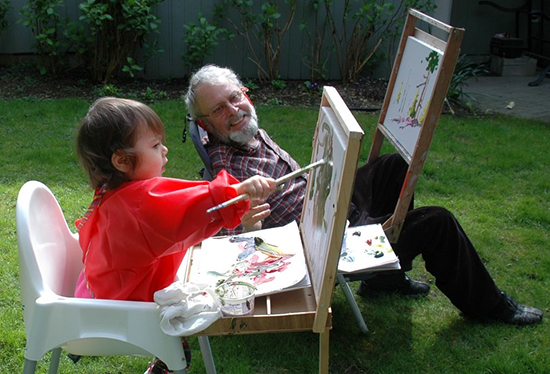 Robert Genn Painting with His Granddaughter Zoe Visit Robert Genn's website to see more of his paintings.
All artwork copyright Robert Genn (used here with permission) Tweet blog comments powered by Disqus |
Become an Artist's Road Member Today!
Already a Member?Log in here. To renew your membership, log in and follow the links. Search the SitePerspectivesNot ready to become a Member yet? Subscribe to our free email postcards, "Perspectives". Enter your email address here.
Member ContentFree ContentThe Artist's Road StoreNocturnes - A Primer on Night Painting Filled with inspirational examples by the masters of nightime painting, this little book is sure to fire up your creative energies. Never tried painting at night? We show you how it's done with a step-by-step-oil demo and a tale of night painting in the wilds of Rocky Mountain National Park. The Primer on Night Painting - Nocturnes is a 7 x 7" PDF download with 40 pages of text and images. It includes a gallery of paintings by masters of the nocturne, information to inspire and encourage you in your plein air nocturne painting, an illustrated step-by-step demo and tips for working in pastel and oil. Also available in a softcover edition. Check out the tools and other products that we use in our own art and travels in The Artist's Road Store. We only offer things for sale that we enthusiastically believe in.
About Us
|
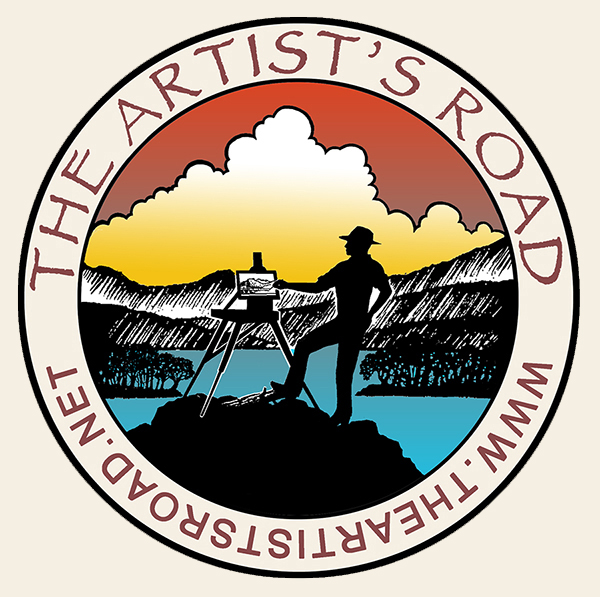
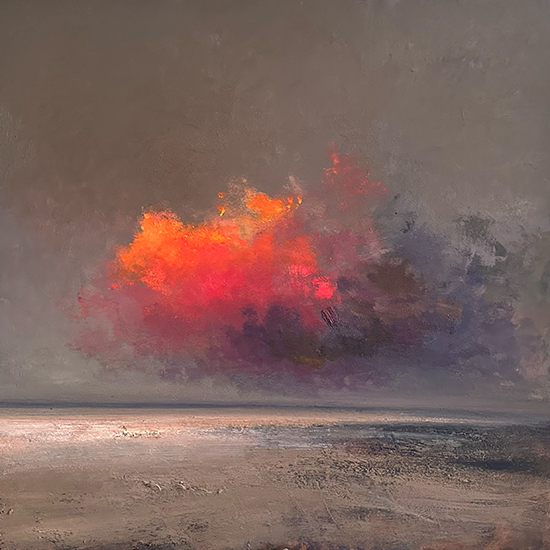 Voices of Experience:Richard K. Blades
Voices of Experience:Richard K. Blades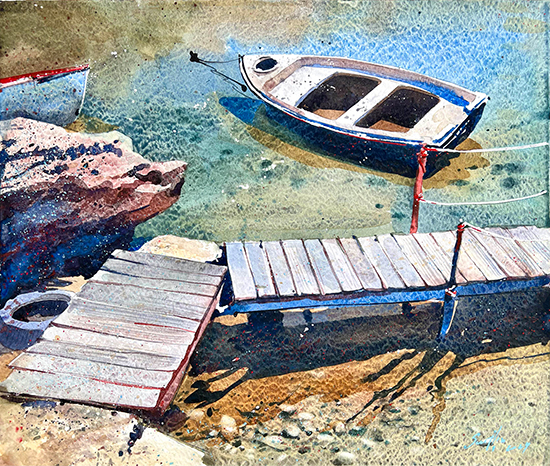
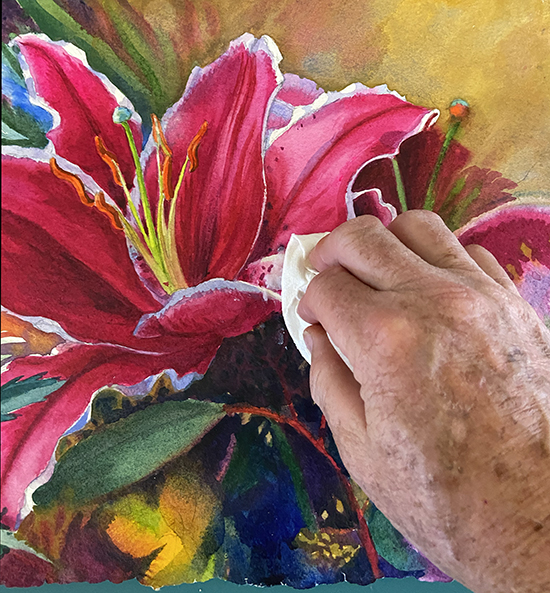 ing Watercolors
ing Watercolors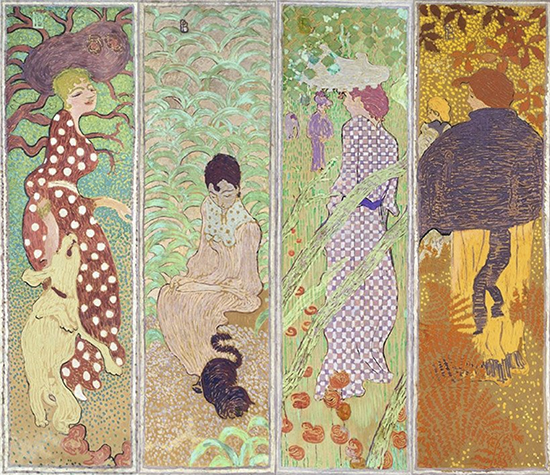
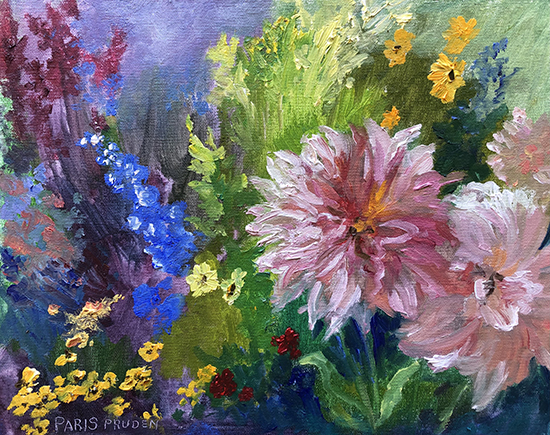
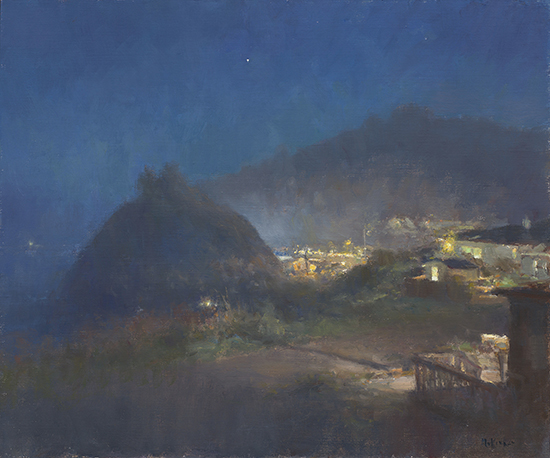 Nocturne Notes
Nocturne Notes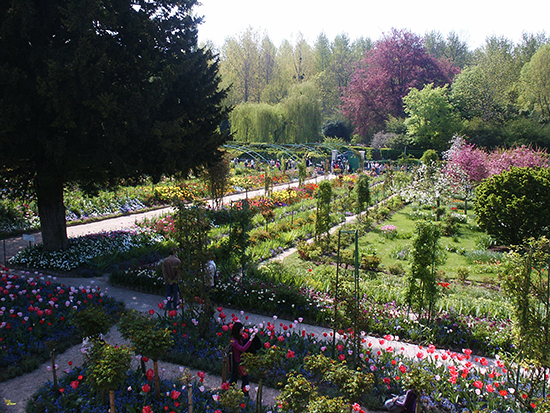 Inspiration in Monet's Gardens
Inspiration in Monet's Gardens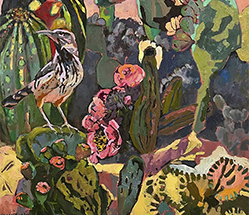
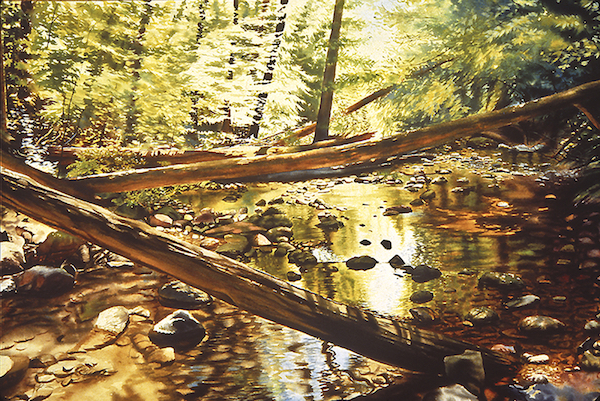 The Watercolor Medium
The Watercolor Medium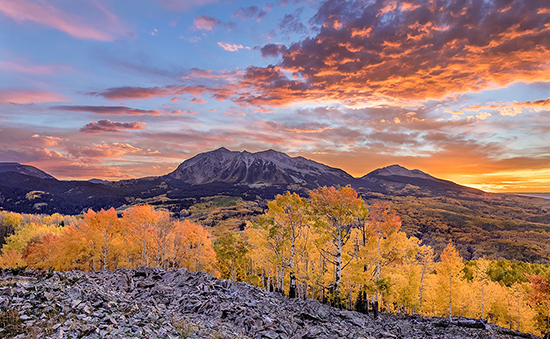
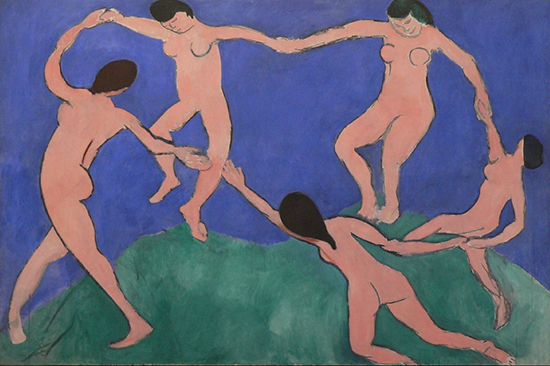 The Perspectives Archive
The Perspectives Archive